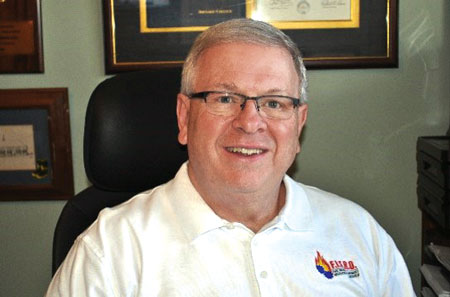
Keeping It Safe Robert Tutterow
There are a couple of innovative approaches to contamination mitigation that are worthy of highlighting. The approaches are designed to minimize the amount of fire-produced contamination brought back into the station following a fire event.
As we learn more and more about firefighter occupational diseases, especially cancer, it is obvious that contamination is front and center in prevention discussions.
The first approach to discuss is a product designed by the University of Illinois Fire Service Institute. It is used during preliminary exposure reduction (PER) and often referred to as gross decon. In describing the product, think of a scaled-down drive-through car wash. Instead of driving a car through a car wash, the firefighter walks through the wash. The process begins with the firefighter walking into the wash still wearing the full personal protective equipment (PPE) ensemble, including the self-contained breathing apparatus (SCBA) with mask donned and on air.
The first stage of the wash includes automatically applying liquid soap. The soap comes from all angles through low-pressure nozzles to soak the firefighter. A unit like this could be mounted on a trailer or a pod. The firefighter can opt to let the soap soak in for a few seconds before proceeding to the next stage where spinning brushes scrub the firefighter. Naturally, the next stage is the rinse stage where the residual soap and residual loosened particles are washed off. The unit I saw did not have a drying feature, but I am sure that could be added.
While a unit like this might not be feasible for every fire station or even every fire department, it could be of great value for use on a regional basis. In addition, it could be very applicable to a training academy or community college/technical center that frequently conducts live fire burns, especially using acquired structures.
As I looked at this unit, I pondered the feasibility of having a separate mobile pod or trailer with showers so firefighters could shower while still on scene. It could have a supply of inexpensive and perhaps disposable coveralls for the firefighters to don while returning to the station.
The second approach involves a detached, standalone facility for cleaning the apparatus, equipment, and PPE before the apparatus reenters the station following a working fire response. The first time I heard about this a couple of years ago was with the Central Valley (MT) Fire District. Then recently, I learned that the Fuquay-Varina (NC) Fire Department has just opened a new station with a similar stand-alone detached building. Clearly, many, if not most, fire stations do not have the space on their land for such a facility, especially in urban areas. Regardless, the idea is one to consider and seriously consider when designing a new station. You never know what might be possible. I have seen a car wash built on top of a Wendy’s fast-food restaurant in Vienna, Virginia!
While I have not visited either facility, the advantages of this approach are enormous. These separate buildings include a drive-through bay for washing the apparatus. This is a logical space for washer/extractors to clean turnout gear. Other cleaning-related units that are a natural fit include drying racks and hangers, SCBA cleaning machines, hose cleaning machines, deep stainless steel double sinks with foot-operated valves for cleaning loose equipment, boot scrubbers, etc. Also consider having showers included for the “shower within the hour” application.
The standalone facility is probably one of the most effective ways to minimize contamination and other harmful byproducts of combustion from getting into a fire station. I liken it to having an effective fire prevention program. An ounce of prevention is worth a pound of cure.
For those wishing to pursue this idea, in addition to the land space requirements, there are cost considerations. Things to consider include knowing that such a facility is likely less costly per square foot compared with the main station. And more importantly, what are the long-term health cost savings? Think about the cost of treating a firefighter with cancer, including lost time, overtime, and the family implications. The prevention of a couple of cancer cases can easily offset the costs of such a facility. And, if a separate facility is not possible, then modifying your existing facilities can be cost justified.
We all need to salute and thank those departments and researchers who are leading the way in keeping firefighters healthy. Thank you!
ROBERT TUTTEROW retired as safety coordinator for the Charlotte (NC) Fire Department and is a member of the Fire Apparatus & Emergency Equipment Editorial Advisory Board. His 44-year career includes 10 as a volunteer. He has been very active in the National Fire Protection Association through service on the Fire Service Section Executive Board and technical committees involved with safety, apparatus, and personal protective equipment. He is a founding member and president of the Fire Industry Education Resource Organization (F.I.E.R.O.).

